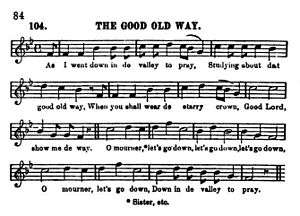Down in the River to Pray
| "Down in the River to Pray" | |
|---|---|
 Sheet music cover | |
| Song | |
| Published | 1867 |
| Genre | Gospel music |
| Songwriter(s) | Traditional |
"Down in the River to Pray" (also known as "Down to the River to Pray," "Down in the Valley to Pray," "The Good Old Way," and "Come, Let Us All Go Down") is a traditional American song variously described as a Christian folk hymn, an African-American spiritual, an Appalachian song, and a gospel song. The exact origin of the song is unknown. Research suggests that it was composed by an African-American slave.[1]
Lyrics and versions

The earliest known version of the song, titled "The Good Old Way," was published in Slave Songs of the United States in 1867.[1] The song (#104) is credited to "Mr. G. H. Allan" of Nashville, Tennessee, who was likely the transcriber rather than the author. The lyrics printed in this collection are:
As I went down in de valley to pray,
Studying about dat good old way,
When you shall wear de starry crown,
Good Lord, show me de way.
O mourner,* let's go down, let's go down, let's go down,
O mourner, let's go down,
Down in de valley to pray
Another version, titled "Come, Let Us All Go Down," was published in 1880 in The Story of the Jubilee Singers; With Their Songs, a book about the Fisk Jubilee Singers.[2] That version also refers to a valley rather than a river.
In some versions, "in the river" is replaced by "to the river". The phrase "in the river" is significant, for two reasons. The more obvious reason is that the song has often been sung at outdoor baptisms (such as the full-immersion baptism depicted in O Brother, Where Art Thou?).[3] Another reason is that many slave songs contained coded messages for escaping. When the slaves escaped, they would walk in the river because the water would cover their scent from the bounty-hunters' dogs.[4] Similarly, the "starry crown" could refer to navigating their escape by the stars.[5] And "Good Lord, show me the way" could be a prayer for God's guidance to find the escape route, commonly known as "the Underground Railroad."
Mistaken attributions
According to some sources, the song was published in The Southern Harmony and Musical Companion in 1835, decades before the effort to gather and publish Negro spirituals gained momentum in the Reconstruction Era.[3] There is in fact a song called "The Good Old Way" in the Southern Harmony Hymnal.[6] That song, however, is a Manx hymn with a completely different melody and lyrics.[7] The lyrics begin as follows:
Lift up your heads, Immanuel's friends
And taste the pleasure Jesus sends
Let nothing cause you to delay
But hasten on the good old way
Notable recordings
- 1927: Price Family Sacred Singers (Okeh 40796)[8]
- 1929: Delta Big Four from Screamin' and Hollerin' the Blues: The Worlds of Charley Patton (Gennett Records)
- 1940: Lead Belly from Let It Shine On Me -- The Library Of Congress Recordings, V. 3 (New Rounder)[9]
- 1966: Doc Watson from Home Again! (Vanguard Records)
- 1970: Arlo Guthrie, single, Reprise Records 0951
- 2000: Alison Krauss from O Brother, Where Art Thou? (Lost Highway/Mercury)
- 2002: Alison Krauss from Live (Rounder)
- 2003: Doc Watson, Ricky Skaggs and Alison Krauss from The Three Pickers (Rounder / Umgd)
- 2005: The King's Singers from Six (Signum UK)
- 2005: Jill Johnson from The Christmas in You (Lionheart Records)
- 2009: Mormon Tabernacle Choir from Come Thou Fount of Every Blessing: American Folk Hymns & Spirituals (Mormon Tabernacle Choir)
- 2012: Sonya Isaacs from Hymns from the Old Country Church (Spring Hill Music Group)
- 2014: Nia Frazier performed a solo to a version of the song on Lifetime's Dance Moms
- 2014: Noah Gundersen partially covered the song on his 2014 album "Ledges". It was titled "Poor Man's Son."
- 2015: DeAnna Johnson performed on The Voice (U.S. season 8).
- 2016: Michael W. Smith from Hymns II - Shine On Us. https://en.wikipedia.org/wiki/Hymns_II_(Michael_W._Smith_album)
See also
References
- 1 2 Slave Songs of the United States at Internet Archive
- ↑ "Come, Let Us All Go Down" Archived October 2, 2013, at the Wayback Machine. in The Story of the Jubilee Singers; With Their Songs, NIU Libraries Digitization Projects
- 1 2 "Let's Go Down in the River to Pray", Martin Barillas, SperoNews, April 13, 2011
- ↑ Smith, Jessie Carney (2010). Encyclopedia of African American Popular Culture. ABC-CLIO. p. 466. ISBN 9780313357978.
- ↑ "Sweet Chariot: The Story of the Spirituals". SpiritualsProject. Retrieved 28 March 2015.
- ↑ "The Good Old Way", Southern Harmony Online
- ↑ "The Good Old Way / Sweet Hope of Glory", Mainly Norfolk: English Folk and Other Good Music
- ↑ Okeh 40000 series numerical listing pt. 2 at the Online Discographical Project
- ↑ "Down in the valley to pray" at Library of Congress